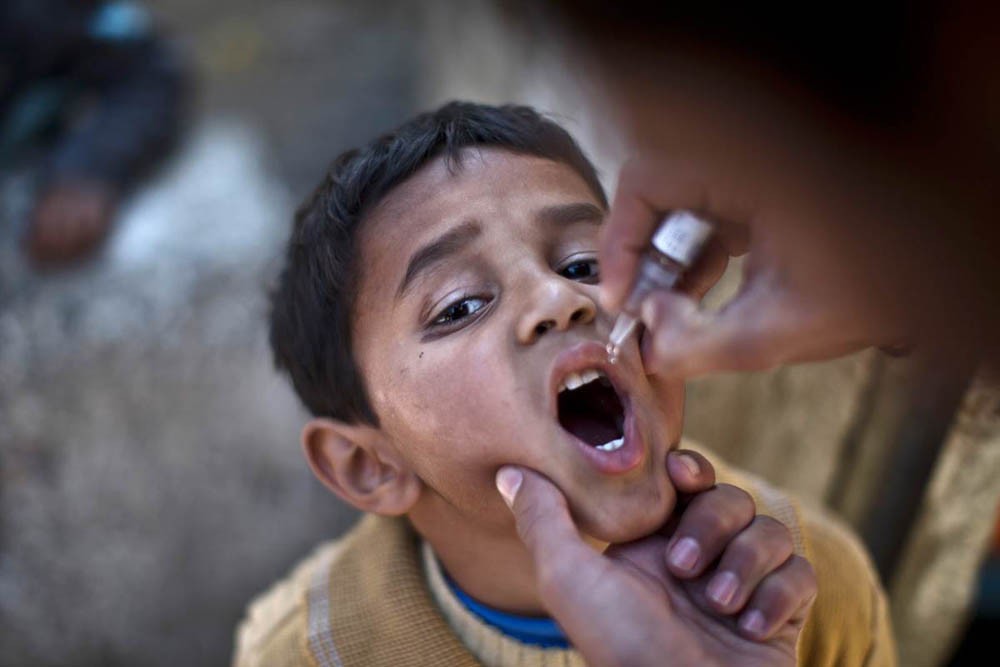
Polio teams vaccinate children in Darkhast Jamal Khan, a remote village in Dera Ghazi Khan district, against all odds

As polio teams went from house to house to vaccinate children on day two of polio National Immunization Day, a large number of women were going to the fields to pick cotton, along with their children as young as one, in this remote village of Dera Ghazi Khan, in South Punjab.
For a health team in the district, which on average covers over 200 households a day, including schools, the onset of cotton-picking season heralds challenges ahead as more and more children are reported "no-show" during house-to-house vaccination campaign.
The scale of polio teams’ efforts is even larger in a village like Darkhast Jamal Khan, located some 16 kilometres from Dera Ghazi Khan city, due to treacherous terrain and scattered houses.
The district is located in one of the remotest areas of the province with dismally low literacy rates, history of polio cases, last reported in 2014, and the routine immunisation coverage just above 25 per cent.
Dera Ghazi Khan shares border with polio-infected districts of Balochistan and Khyber Pakhtunkhwa which makes it more vulnerable, hence, it is categorised in tier-2 in the list of polio-prone districts -- tier-1 districts being the ones in FATA, Khyber Pakhtunkhwa, Sindh and Balochistan.
"For us the cotton picking season is very tough," says Rafiq Ahmad, the team leader in the village of Basti Saker Bagalani.
"We knock at the doors and find nobody. It is a continuous exercise. We go again and check in the evening and find that a few children are still not available. Search and vaccination continues for days till the last child is vaccinated," he adds.
With the vaccination of children in households, the job of health teams is not finished here. The season also spells problems for health teams as some children travel with their families in search of livelihood from areas infected with polio virus. Such children are considered high risk populations due to their mobility, vulnerability to vaccine-preventable diseases, including polio. Reaching out and vaccinating such children requires separate plans.
"We try to vaccinate these children on the first day of the campaign. Such on-the-move populations are marked red in our maps," says Muhammad Akhtar, a health worker in Basti Ahmadani.
"Such children are very poor, mostly malnourished, they don’t have access to clean water and sanitation facilities as well as no educational opportunities," Akhtar says.
For Rafiq and 34,000 frontline health workers in the vast 36 districts of Punjab, the job is by no means easy. For the children who are missed during the three-day campaign and the two-day catch-up, another extended catch-up pursuit continues for 14 days.
"We maintain lists of such population with complete addresses incorporated in our daily plan along with the name of the head of the family," Akhtar informs.
"As they have limited livelihood resources they move from one place to another and live in unhygienic conditions, thus making them more vulnerable to polio," he says.
"The key is to meet with the elders of such areas so that wherever they go they vaccinate their children at the health centres or from the teams," he adds.
Director of the Expanded Programme on Immunisation in Punjab, Dr Munir Ahmad, appreciates the work of the health teams. "Frontline health workers are the real force in the elimination of polio; have pivotal role in defeating the virus once and for all," he says, adding, "More than 200,000 motivated men and women across Pakistan have been selected from their local communities, and trained with state of the art tools to ensure every child is reached and every parent can trust vaccinators to protect their children from polio."
In recent months, the Pakistan polio programme has refocused its efforts in tracking the virus to the remaining reservoirs and in finding and vaccinating the continuously missed children among the highest risk population to close the immunity gap.
The number of children paralysed by polio has dropped by 80 per cent from last year. The immunity gap is now closing but the virus is still attacking unprotected children. Finding and vaccinating these persistently missed children will leave the virus nowhere to go.
"We have to track children and check their vaccination status and then administer them polio drops. This is the least we can do for them; we are working for a noble cause of protecting the future of children", says Rafiq.